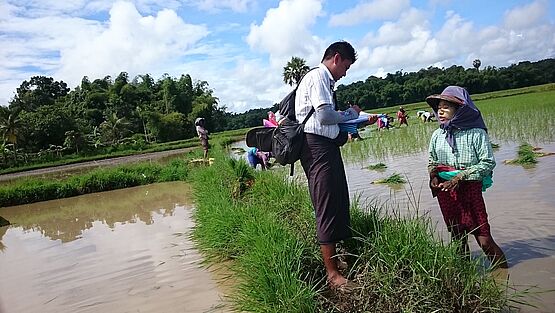Monitoring
To become an effective change agent in dynamic systems, continuous learning and adjusting are essential. Interventions should not only be assessed retrospectively but continuously, so that they can be adapted on an ongoing basis. It is important to establish feedback loops that allow us to understand early whether an intervention is working in the way it was intended to. It is critical to build up a learning culture in the team. This culture needs to foster personal curiosity, support experimentation, accept failure, and value learning and continuous improvement.
We support our clients to develop a Monitoring, Evaluation and Learning (MEL) framework that is geared towards learning and adjustment, but also allows accountability to donors and other stakeholders.
There are some elements that are generally present in a good MEL framework.
- A Theory of Change which is sensitive to complexities and uncertainties in economic development shapes the centre of the framework. It makes the hypothesis of the initiative explicit as to how its interventions are intended to achieve change.
- A second element of the MEL framework needs to focus on monitoring intervention performance. This involves taking an ‘inwards-out’ perspective by monitoring the progress of individual interventions, starting with the project’s activities and then moving outwards to examine the effects of the interventions.
- In addition to intervention performance, an assessment of changes in the wider context is important, regardless of whether the changes have been caused by the project or not. This involves observing changes in the context and then considering how the project might have contributed towards them, or how they might influence the project’s future strategy. This element provides an ‘outwards-in’ perspective, which may also be useful in identifying new opportunities in the market.
The actual learning occurs when the team members sit down together and ask: What do the data and observations tell us? What is really going on? Why is this happening? How does that make sense? How does this fit our hypotheses and Theory of Change?
Reviewing and integrating of the monitoring results brings together the results of the ‘inwards-out’ and ‘outwards-in’ elements. This is a process to establish a plausible narrative on the effects of the project and its interventions. It provides the basis for adapting interventions as well as for reporting to funders, project partners, beneficiaries and other relevant actors.
There is no best-practice frameworks that projects can simply adopt. Each case is specific and requires an adapted framework, which we co-develop together with our clients.

Additional Resources
Read blog articles by Marcus Jenal on monitoring and complexity:
www.jenal.org/category/monitoring-and-complexity-articles/

